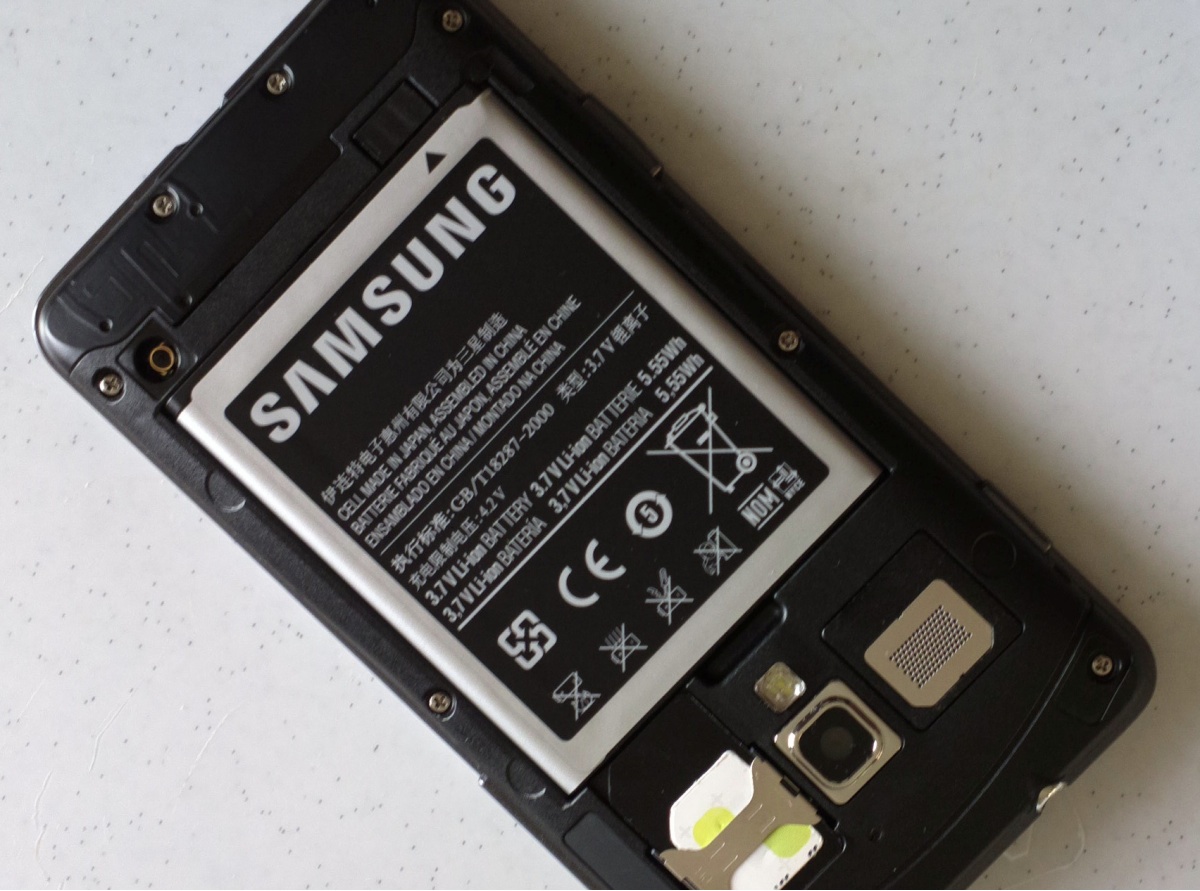Review: Samsung Omnia M
Score:
69%
I have to say that the new Samsung Omnia M is something of an oddity. Firstly because you'll almost certainly have either not heard of it or seen it, thanks to an exclusivity deal (in the UK, at least) with Phones 4u. Secondly, because this Windows Phone 7.5 handset is very late in the day. Very. We're talking about only a couple of months until we've got Windows Phone 8 handsets coming out of our ears - and the Omnia M, like all the other Windows Phone 7.5 hardware, can't be upgraded to version 8 of the OS. Moreover, it's a somewhat bewildering combination of both sumptuous and stingy components...
Buy Link | Download / Information Link

Context and caveats
To make up for its extreme lateness (in terms of platform and specifications), you'd hope that the Samsung Omnia M would at least be cheap. Sadly that's not the case and Nokia's (more or less equivalent device, the) Lumia 610 retails for (from) £10 a month on contract and is just over £100 SIM-free, while Samsung's Omnia M is only available on contract from Phones 4u in the UK and is £20 a month for 2 years, which is on the expensive side, when considering the rest of the phone market in general and the Windows Phone scene in particular. The few sites prepared to quote prices for 'pre-orders' for the Omnia M are saying around £300 SIM-free, which again makes little sense.
However, if the Omnia M had been specified like even the 2011 budget-price Nokia Lumia 710, there might not have been so much of an issue. After all, there's a really solid build, a thoroughly gorgeous Super AMOLED screen and a better than average camera. However, aside from the worries about signing a two year contract for a phone that's going to be superceded in two months, and aside from my worries about lack of RAM (of which more below), there's a showstopping, crippling problem with the Omnia M.
Out of the box, once you've applied the waiting Windows Phone Marketplace updates, there's only just over 2.5GB of storage on this phone*. And no way to expand it with microSD (as with all the Windows Phone 7.5 generation devices). Contrast this to, say, 8GB of sealed in storage on the likes of the Nokia Lumia 610, a cheaper device, giving roughly three times the space, or 16GB on the Lumia 800, with roughly six times the free space. When there's (just about) enough storage memory, 'sealed and non-expandable' can be made to work. When there's simply not enough, the poor user will be fighting all the time just to keep their phone-tech heads above water.
* Note that a 8GB internal disk model, with 6.5GB available out of the box, is available in some world markets

Two and a half Gigabytes may sound a lot if you think about it as 2,500 Megabytes. But the Omnia M buyer is going to start using the device for real - they'll plug it into Zune Desktop and sync across a dozen of their favourite music albums. That's almost a Gigabyte gone. They'll dive into the Windows Phone Marketplace and install a few decent games. That's another GB gone. With their PIM data in place, perhaps a mere two weeks into ownership, they'll be out at an event and want to take a video clip on their shiny new phone and will be hit with an error 'Not enough memory - please delete some content'. And that's the point where they'll see red - selling a 2012 smartphone (or indeed a 2008 one) with just 2.5GB of unexpandable memory is nothing short of criminal.
This isn't just me, a power user, complaining. I'd complain if a phone only had 8GB in 2012. But the Omnia M's restrictions inconvenience average people, 'normobs', people who won't know any better. Yes, as a power user, I can appreciate that Windows Phone 7 is something of a cloud-based mobile OS and that the Omnia M could (just about) be pressed into service as a cloud-access phone with all music and media streaming in via 3G or Wi-fi. Just about. Even then, the whole idea is rather tenuous.
Samsung, utterly ironically, even bundles 'AllShare', its DLNA media sharing utility, with the default being to share wirelessly your (not at all) vast media library of videos, photos and music with DLNA-compliant playback devices around you. At least there's the option to play back media from DLNA servers as well, with videos and music stored on other computing devices you might own.
The aforementioned 384MB of RAM is another example of resource cost cutting. The core UI and built-in applications work quickly enough. But applications (what a difference 128MB of RAM makes!) don't get kept in memory ('tombstoned') to the same degree as on 512MB devices (like the Nokia Lumia 710 and 800, or even Samsung's previous Omnia 7 from two years ago!), so there's far less chance that the application you want next will be preserved in RAM and available to be 'fast app switched' into. So it's generally slower to jump around than on the Windows Phones with 512MB of RAM - many applications effectively have to grind into action afresh each time (sometimes preserving your context from the last time you used them, sometimes not).
Of course, you could argue that casual Windows Phone virgins wouldn't even know about fast app switching and 'best practice' with RAM and would effectively start every application from scratch every time anyway, via the main application menu. Such a user would quickly get used to these small app startup delays as part of the general speed of the device, their 'first smartphone'. However, I do wonder whether, in a world in which Google has activated half a billion Android smartphones, all of which have full multitasking and instant application switching, perhaps even the most novice user is going to notice that their phone "is a bit slow" once they start pushing it beyond just the very basics.
Omnia M - the hardware
With this context and caveats out of the way, there's quite a bit to admire on the Samsung Omnia M. The shiny, slate grey plastic case feels great in the hand and there are no squeaks or creaks whatsoever. Top and bottom slanted panels on the back are deliberately textured and angled to both fit well in the palm of your hand and fingers, and to give a modicum of extra grip.
The back peels off to reveal a replaceable 1500mAh battery, so keeping the Omnia M powered won't be an issue and you'll always have options. Unusually, for a late 2012 phone, the SIM slot is for a full size card, though I had no trouble using my microSIM inside a cheap adapter, since there's no complicated mechanism for adapter edges to get caught in.

The Omnia M's front is unusual in that only the Windows icon is stencilled on. The 'back' and 'search' icons appear from the black panel when needed, lit up by LEDs underneath. Most of the time you have to guess where 'back' is, as the icon only lights up after you've actually tried to press it, though with only one button either side of the Windows key, it's not hard to remember where to press. I'm guessing this is all part of power saving, since the Windows key doesn't light up at all - it's just very reflective. So, most of the time, no LED power is required at all for the bottom of the Omnia M. As I say, unusual.
The Super AMOLED display is super in terms of colour rendition - tech purists will hate that it's a pentile display, but my eyes had no issues with it and in any case it's now been proven that pentile displays last longer. In terms of contrast and colours, I'd place the Omnia M's screen as comparable to the Nokia Lumia 800's, which is a distinct compliment. (It's just so ironic that such a good screen, form factor and materials are being held back by the penny pinching on storage memory and RAM.)
The Omnia M has Samsung's usual excellent arrangement of the power/wake button being on the top of the right hand side - for right handers, at least, there's no awkward stretching, the phone can get woken up with one press of a button that naturally falls under the right thumb. A volume rocker on the left side, 3.5mm out on the top and a microUSB port on the bottom complete the hardware.
The box contents show signs of cost-cutting, with no earbuds or any kind - Samsung are assuming you'll use your own headphones. While I applaud the 'green' thinking here, for smartphones it's never terribly clear whether 4-pole headsets (i.e. with integral microphone) will work and if so, which 4-pole standard is used. Which is why most handsets come with a headset that, while not perhaps being of top quality in terms of audio, at least is guaranteed to function.
See also my full gallery of Omnia M photos for more shots of the device from various angles.
Camera and speaker
Thankfully, Samsung has kept back one of its better cameras for the Omnia M, I'd put it up with the Galaxy S and SII from the Android world, and I was consistently impressed by the details and colours captured. The interface is bog standard Windows Phone, as with all the other WP 7.5 handsets, though camera operation was more foolproof than on the Nokia Lumia handsets, thanks to a focussing reticule which disappears if no focus lock can be obtained (it sticks around on the Lumias, confusingly).
Here are a few sample photos, click on each to download the original or enlarge:
Taken in weak sun, but still very accurate focussing and great colours
Taken in overcast, rainy conditions, focussing on the sign....
Proving the wet conditions, this was taken in pouring rain - at least the snail was enjoying the weather!
LED flash photos are as disappointing as for other LED-equipped smartphones, the system's not even worth using - but then, as regular readers will know, only Xenon flash will do for me. However, as shown above, it's easy to get rather excellent stills in natural light with the Omnia M's camera, so credit where credit's due. It's also worth noting that all photos looked rather splendid on the Super AMOLED screen, on which all colours seem vivid.
Video capture is at the disappointing VGA resolution (at the maximum 'high' setting) with no focussing of any kind - and with indistinct audio - here's a short sample (6MB). It's something of a mystery how stills can be so excellent and video capture so disappointing in the same device and one can only presume a lack of care and attention somwhere in Samsung's design team and Q&A departments.
In addition to screen and camera, the other hardware staple in the media department is the speaker, of course. And this is quite decent, better in tone than that on the Nokia and HTC Windows Phones - it's no Nokia N8 or Apple iPhone 4S competitor in the raw volume stakes, but it's not unpleasant to listen to and is perfectly pleasant for casual podcasts, video watching or speaker phone calls in a normal living room or office.
Battery life and power
Perhaps because of the lower RAM quotient and the use of a AMOLED screen, together with a default 'dark' theme and dark-friendly add-on applications, battery life on the Omnia M was excellent, it clung onto battery bars better than any previously tested Windows Phone. The use of a largish 1500mAh battery, for which replacements (part no. T18287) can be cheaply and easily sourced, takes away any small power worries a user might have. Provided you stay away from predominantly white web page browsing, the Omnia M's battery life and flexibility won't disappoint.

Windows Phone and extras
The Omnia M launches with Windows Phone 7.5, so there were no updates ready to be applied by Zune Desktop. It's not definite that it will get Windows Phone 7.8, though it's not unlikely. Not that the target market for this phone will notice one way or the other - in fact, it might be better for Samsung not to authorise the update since the change in interface would confuse buyers and the increased resource requirements might lead to even lower internal storage and RAM.
Unlike Nokia with their Lumia devices, there aren't any truly huge additions made here to the standard Windows Phone 7 application set. But Samsung do throw in a few goodies:
- Now (a rather nifty 'Daily Briefing' of news, weather, stocks, currency and even 'top tweets' for various countries)
- AllShare (DLNA wireless sharing of media to and from other compatible equipment around the home)
- ChatON (Samsung's proprietary chat/file transfer system)
- FunShot (a camera effect novelty)
- MiniDiary (as it sounds, an electronic diary, with sharing, camera and weather integration)
- Photo Studio (basic photo editing and correction tools)
- Photogram (an Instagram clone, sharing to Facebook, Twitter, Flickr, Picasa and Photobucket)
Ewan will be covering most of these in his day to day testing of the Omnia M shortly in part two of our review here on allaboutwindowsphone.com, along with his own take on the performance of the device day to day and week to week. A masterpiece in budgeting and minimalism or a horrendously miscalculated attempt to woo the mid-tier customer?
Watch this space.
Disclosure: This review handset was loaned by Phones 4u. Phones 4u stocks a number of Windows Phone devices and other smartphones, including the Samsung Omnia M, in both its retail and online stores.
Reviewed by Steve Litchfield at



